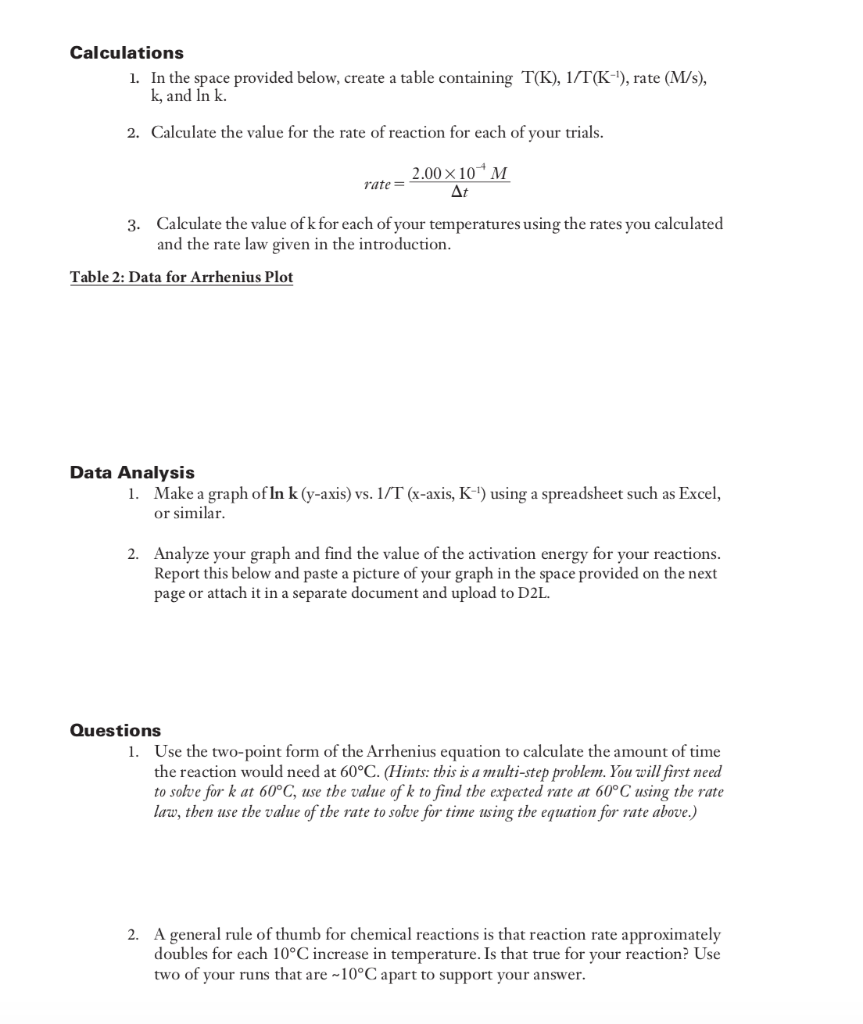Answered step by step
Verified Expert Solution
Question
1 Approved Answer
Change in Temp (Cel) Temp K Time (s) Rate (M/s) k Concentration of S2O3 1/T(K^-1) ln(k) Ea 0.373 283.244 408 4.90E-07 76.5938 0.0002 0.003531 4.33852

| Change in Temp (Cel) | Temp K | Time (s) | Rate (M/s) | k | Concentration of S2O3 | 1/T(K^-1) | ln(k) | Ea |
| 0.373 | 283.244 | 408 | 4.90E-07 | 76.5938 | 0.0002 | 0.003531 | 4.33852 | -3.52 |
| -1.274 | 294.583 | 170 | 1.18E-06 | 183.75 | 0.003395 | 5.21358 | -3.38 | |
| 1.09 | 306.159 | 50 | 0.000004 | 625 | 0.003266 | 6.43775 | -3.25 | |
| 313.6 | 28 | 7.14E-06 | 1116.09 | 0.003189 | 7.01759 | -3.18 |
Please help! I can't figure out how to do the last section. The questions section with the two-point form of Arrhenius equation. The table is all the data my partner and i got from our activation of energy lab. we mixed test tube a and b and timed how long a color change took. Thank you!!
Calculations 1. In the space provided below, create a table containing T(K), 1/T(K), rate (M/s), k, and In k. 2. Calculate the value for the rate of reaction for each of your trials. rate= 2.00 x 10* M At 3. Calculate the value of k for each of your temperatures using the rates you calculated and the rate law given in the introduction. Table 2: Data for Arrhenius Plot Data Analysis 1. Make a graph of In k(y-axis) vs. 1/T (x-axis, K-") using a spreadsheet such as Excel, or similar 2. Analyze your graph and find the value of the activation energy for your reactions. Report this below and paste a picture of your graph in the space provided on the next page or attach it in a separate document and upload to D2L. Questions 1. Use the two-point form of the Arrhenius equation to calculate the amount of time the reaction would need at 60C. (Hints: this is a multi-step problem. You will first need to solve for k at 60C, use the value of k to find the expected rate at 60C using the rate law, then use the value of the rate to solve for time using the equation for rate above.) 2. A general rule of thumb for chemical reactions is that reaction rate approximately doubles for each 10C increase in temperature. Is that true for your reaction? Use two of your runs that are -10C apart to support your answer. Calculations 1. In the space provided below, create a table containing T(K), 1/T(K), rate (M/s), k, and In k. 2. Calculate the value for the rate of reaction for each of your trials. rate= 2.00 x 10* M At 3. Calculate the value of k for each of your temperatures using the rates you calculated and the rate law given in the introduction. Table 2: Data for Arrhenius Plot Data Analysis 1. Make a graph of In k(y-axis) vs. 1/T (x-axis, K-") using a spreadsheet such as Excel, or similar 2. Analyze your graph and find the value of the activation energy for your reactions. Report this below and paste a picture of your graph in the space provided on the next page or attach it in a separate document and upload to D2L. Questions 1. Use the two-point form of the Arrhenius equation to calculate the amount of time the reaction would need at 60C. (Hints: this is a multi-step problem. You will first need to solve for k at 60C, use the value of k to find the expected rate at 60C using the rate law, then use the value of the rate to solve for time using the equation for rate above.) 2. A general rule of thumb for chemical reactions is that reaction rate approximately doubles for each 10C increase in temperature. Is that true for your reaction? Use two of your runs that are -10C apart to support yourStep by Step Solution
There are 3 Steps involved in it
Step: 1

Get Instant Access to Expert-Tailored Solutions
See step-by-step solutions with expert insights and AI powered tools for academic success
Step: 2

Step: 3

Ace Your Homework with AI
Get the answers you need in no time with our AI-driven, step-by-step assistance
Get Started


